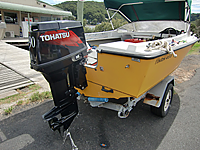The following is a checklist of the important items you need to do every time you move your boat. We have also included a few maintenance tips to reduce your chances of breakdown on the trip.
Basic
- Check engine and battery fluids (Tow vehicle and boat).
- Check rubber hoses, drain plugs, and belts for both motors. Test run the boat motor with a flushette, looking for leaks.
- Check for basic tools, extra fluids, and spare alternator belt and propeller.
- Check your safety equipment for condition and expiration dates.
- Tell a friend or neighbour, where you are going boating and when you'll be back.
Towing
- Check tyre pressures on the tow vehicle and trailer. Improperly inflated tyres can cause sway and tyre failure. Don't forget the spare tyre.
- Make sure the wheel nuts on the tow vehicle and trailer are tight. Most require specific tightening with a torque wrench (see your owners manual).
- Check that the hull is snug with the bow stop and secured with a chain and tie down. Do the same with the rear tie downs. Check winch, line, and tie downs for wear.
- Be sure the coupler is secured and the hitch ball is the proper size. Insert a bolt or locking device into the hole in the coupler latch, so it won't accidentally pop open. Some model couplers have a hole on the side of the coupler near the hitch ball socket that is intended for a padlock. Be sure to check that this lock won't get caught between the coupler and the hitch. If it does, you may have to install a raised shank hitch ball.
- Be sure the trailer jack is raised and locked in place.
- Check that the wiring is properly hooked up and working on your vehicle and your trailer. Don't assume that it is. Check that it won't get pinched between the coupler and hitch when turning.
- Be sure the safety chains are in place and won't pop off. Always go to the frame and not the bumper.
- Check the trailer brakes and safety chain if equipped. Some brakes systems have a brake bypass lever that disables the brakes when backing up. Be sure it is in the proper position for trailering.
- All equipment inside the boat should be tied down or properly secured.
- With the trailer hooked up ready to tow, make sure all mirrors are properly adjusted.
- All safety equipment should be stowed in the boat. This includes all NSW Maritime Coast Guard (NSWMCG) requirements for PFDs (life jackets) a throwable floatation device, fire extinguisher, whistle or horn, distress signals, and whatever other NSWMCG and local regulations require.
- The engine and/or outdrive should be in the up position and secured.
- If a boat cover is used when towing, it must be properly secured or it will blow off while trailering. (DO NOT trailer a boat with a cover that is not custom fitted for trailering.)
At the Launch Ramp Parking Lot
Note: Try to use the following launch ramp techniques and steps so as to make it easier and faster for everyone in line in front of you and behind you.
- Remove cover and stow in vehicle.
- Remove tie downs, but leave the bow winch rope and safety chain on.
- Remove motor support or trailering bracket.
- Un-plug the trailer wiring from tow vehicle.
- Get into the boat and check it over .... check boat, bilge blower, bilge pumps, lights.
- Load your gear on the boat.
- Set up your dock lines, fenders, and boat hook.
- Install the drain plug(s) in the hull.
At the Launch Ramp
- Recheck drain plug(s).
- If the boat is an I/O, turn on the engine room blower.
- Back down the ramp far enough to allow engine cooling water to be picked up.
- Put the tow vehicle in "Park", set the emergency brake and block the rear wheels of the tow vehicle. Never block the front wheels.
- Lower the engine/outdrive, making sure that there isn't any contact with the ground.
- Start the boats engine and warm it up.
- If clearance permits, check shifting operation of the boat before releasing the winch hook.
Time to Go Home
- Back the trailer into the water but not too deep, a boat floating freely over a trailer that is too deep will not load properly. Most boats load properly if the boat's bottom can center itself in the bunks or rollers of the trailer, when the boat is about 1/3 to 1/2 the distance up the distance onto the trailer.
- Pull or drive the boat slowly to the trailer, making sure that the boat's center keel lines up with the center of the trailer or keel roller.
- Use engine power and steering to keep the boat straight with the trailer before winching or powering on.
Note: At some launch ramps, it is illegal to power your boat onto the trailer. Be sure to ask before doing so.
- Raise the engine so the prop will not hit the ramp while winching and driving up the ramp.
- When the boat slips into the bow stop and the winch hook is tighten, install the safety chain.
Special Note: If your trailer doesn't have a safety chain between the winch post and the bow eye of the boat, you run the risk of loosing your boat on the launch ramp, if the winch or winch rope breaks.
- Finish tying it down and secure it for the road as far away from the ramp as possible.
- Remove the drain plug.
- Wash off the trailer and boat as soon as possible. If you run in salt water be sure to flush the motor.
